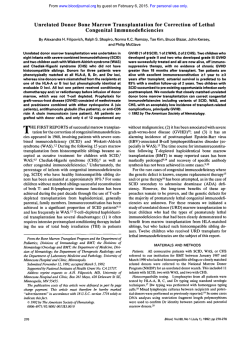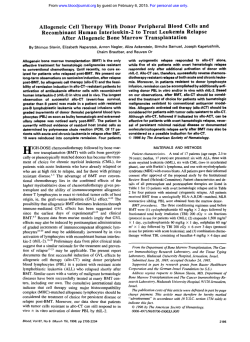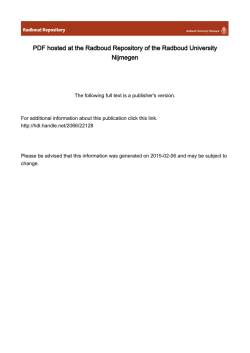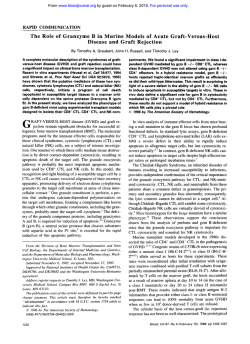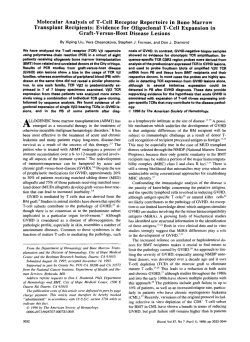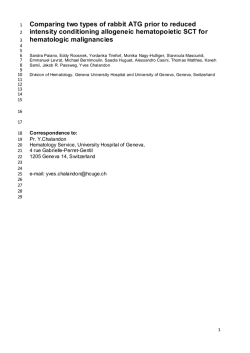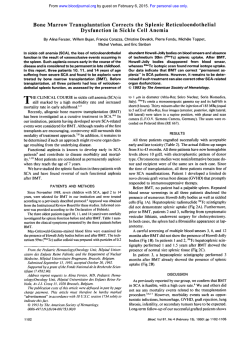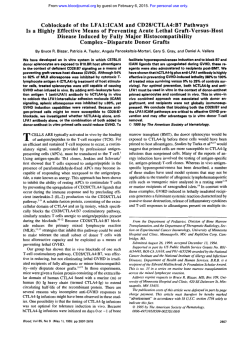
PDF hosted at the Radboud Repository of the Radboud University
PDF hosted at the Radboud Repository of the Radboud University Nijmegen The following full text is a publisher's version. For additional information about this publication click this link. http://hdl.handle.net/2066/22068 Please be advised that this information was generated on 2015-02-06 and may be subject to change. Acute Graft-Versus-Host Disease: Grade and Outcome in Patients With Chronic Myelogenous Leukemia By A. Gratwohl, J. Hermans, J. Apperley, W. Arcese, A. Bacigalupo, G. Bandirli, P. di Bartolomeo, M. Boogaerts, A. Bosi, E. Carreras, A. Devergie, A. Ferrant, W.E. Fibbe, F. Frassoni, G. Gahrton, J. Goldman, A. Iriondo, N. Jacobsen, H J. Kolb, H. Link, M. Michallet, H.G. Prentice, J. Reiffers, F.v. Rhee, T. Ruutu, H. Schwaighofer, J.P. Vernant, T. de Witte, and D. Niederwieser for the Working Party Chronic Leukemia of the European Group for Blood and Marrow Transplantation Acute graft-versus-host disease (aGVHD) has been classified according to the Seattle criteria as grades 0, I, II, III, and IV for 20 years. The predictive value of such detailed grading is a matter of debate; publications usually report GVHD as present or absent or as absent, moderate, or severe. The Working Party Chronic Leukemia of the European Group for Bone Marrow Transplantation analyzed data of 1,294 pa tients transplanted from an allogeneic donor for chronic my elogenous leukemia (CML) in first chronic phase and tested the predictive value of aGVHD grading for the following end points: day 100 mortality (D100M), transplant-related mor tality (TRM), relapse incidence (Rl), leukemia-free survival (LFS), and survival (SURV). aGVHD was absent in 462 pa tients (35.7%), grade I occurred in 335 (25.8%), grade II in 264 (20.5%), grade III in 110 (8.5%), and grade IV in 123 pa tients (9.5%). A total of 297 patients (23%) died within 100 days, 495 patients (38%) died of any TRM, and 100 patients (8%) died of relapse. D100M according to grades 0, I, II, III, and IV was 17%, 13%, 19%, 38%, and 70%, respectively, with significant difference between 0-II versus lll-IV. TRM was 28%, 27%, 43%, 68%, and 92%, respectively, with a distinct separation between 0-I versus ll-IV. Rl showed a continuous decrease of 37%, 30%, 23%, 18%, and 8%, respectively, with increasing aGVHD. LFS was 45%, 51%, 44%, 26%, and 7%, respectively, and was best for patients with grade I aGVHD. This finding was also reflected in a better overall survival (60%, 64%, 53%, 30%, and 8%, respectively). The better LFS for grade I aGVHD patients compared with patients with grade 0 or II aGVHD was confirmed (P —.05) in a multivariate analysis. These data document the value of the present 5point grading of aGVHD, ie, different outcome is observed depending on endpoint analyzed. Restricting information about aGVHD to presence or absence is not warranted. G The data were collected by questionnaire containing information on donor and recipient identity, sex, age, and histocompatibility. Moreover, patient data were available on primary disease, transplant procedure, conditioning, GVHD prevention method, and outcome. The data were collected annually and updated as of January 1, 1993, For logistic reasons, not all teams reported all their patients. Some teams ceased to report, whereas some only began reporting at a later stage. The participating institutions are listed in the Appendix. Patients. The present analysis concentrates on 1,294 with CML transplanted in first chronic phase of their disease with bone marrow from an allogeneic donor. Identical twin transplants and patients with second transplants were excluded. Table 1 summarizes the patient and transplant characteristics in regard to age, donor recipient sex combination, GVHD prevention method, donor source, year o f transplant, and interval from diagnosis to transplant. Of the 1,294 patients with CML, 58% were male and 42% were female. Male patients receiving female bone marrow represent 330 cases (26%). The median age was 33 years, with a -two patients range from 0.5 to 58 years. One ) were 20 years or younger and 1,142 patients were older than 20 years. The donor was an HLA-identical sibling in 90% of the patients (n - 1,160) and a nonidentical related or unrelated donor in 10% (n = 134). For 30% of all patients (n = 385), donor marrow was T-cell depleted as method of GVHD prevention. Fifty-five percent o f transplants were performed before 1988 and 45% between I98K and 1990. The interval from diagnosis to transplant was ssl year in RAFT-VERSUS-HOST disease (GVHD) remains a major complication o f allogeneic bone marrow trans plantation (BMT) and a significant determinant for out come.'-6 Acute GVHD (aGVHD) is traditionally classified according to the Seattle criteria in a 5-point clinical staging system according to the three main organs involved: skin, gastrointestinal tract, and liver.1 Based on these organ scores, an overall clinical grading was defined from 0 to IV. The value of such a finely tuned classification system as a pre dictive tool has never been analyzed in detail. In some analy ses, patients with overall grades 0 and I are considered as “ aGVHD absent” and patients with grades II, III, and IV as “ aGVHD present.” Alternatively, aGVHD is reported as absent (grade 0), mild or moderate (grades I and II), or severe (grades III and IV). Using a large cohort o f patients treated with allogeneic BMT for one indication, chronic myelogenous (CML) in first chronic phase, we examined the influence and prognostic value o f this 5-point overall grading system o f aGVHD. Our study was initiated by a workshop held at a UCLA conference on bone marrow transplantation (January 1994, Keystone, CO) and intended as a review of the 25 years of experience with the Seattle criteria that addressed the prognostic value of the 5-point grading on the following endpoints: day 100 mortality (D100M ), transplant-related mortality (TRM), relapse incidence (Rl), leukemia-free sur vival (LFS), and overall survival (SURV). In addition, the conventional 5-point scale was compared with a dichoto mised system using absence or presence o f GVHD and a system using absent, moderate, or severe as grading. PATIENTS AND METHODS Study design and data collection. The present analysis is a retro spective study based tin data collected by the EBMT between 1979 and 1990. Blood, Voi 86, No 2 (July 15), 1995: pp 813-818 © 1995 by The American Society of Hematology. From the Division o f Hematology, Department o f Research, Kan tonsspital Basel , Basel» Switzerland. Submitted October 7, 1994; accepted February 27 s 1995. Address reprint requests to A. Gratwohl , PhD , Division o f Hema tology, Kantonsspital BaseL CH-403/ Basel , Switzerland. The publication costs o f this article were defrayed in pari by page charge payment . This article must therefore be hereby marked hH CIS.C. section 1734 solely to 'C w *‘advertisement ’ in acca indicate this fact. (O 1995 by The American Society o f Hematology. (ì(ì0()~497ì/95A^()24H)()9$3,00/n 813 GRATWOHL ET AL 814 Table 1. Incidence and Severity of aGVHD Depending on Age, Sex, T-Cell Depletion, Donor Source, Year of Transplant, and Interval From Diagnosis to Transplant for 1,294 CIVIL Patients With an Allogeneic BMT in First Chronic Phase Probability of Significant Differences Between Categories (P) Grade of aGVHD (%) Patient Category Total Age of patient (yr) ^20 >20 No. of Patients (%) 0 I II III IV 1,294 (100) 35.7 25.8 20.5 8.5 9.5 152 (12) 1,142 (88) Donor recipient sex combination Female donor/male recipient Other GVHD prevention method No T-cell depletion T-cell depletion Donor source HLA-identical sibling Nonidentical related donor Unrelated donor Year of BMT =£1987 ^1988 330 (26) 964 (74) 909 (70) 385 (30) 42 35 37 35 29 51 25 26 22 27 26 26 17 21 20 21 23 14 5 9 9 9 10 6 incidence (0 v l-IV) Severity (0 to IV) .1* .It ,62* .58t < .0 0 1 * <.001 + .009* .002+ .03* .48t .004* <,001 * 11 9 12 9 12 4 1,160 (90) 44 (3) 90 (7) 37 32 21 26 32 26 20 11 26 8 2 14 9 23 13 718 (55) 576 (45) 38 32 23 30 20 21 8 9 11 8 592 (47) 352 (28) 328 (26) 39 28 35 28 26 23 18 24 22 7 9 10 7 13 10 Interval between diagnosis and therapy (mo) 0-12 13-24 >24 * x 2 test. t Mann-Whitney test. £ Kruskall-Wallis test. 47%, between 1 and 2 years in 27%, and more than 2 years in 26% of the patients. Grading o f aGVHD and endpoints. The participating teams were asked to enter the grade of aGVHD according to the Seattle criteria.1 To investigate the inlluenee of the aGVHD grade, we looked at several endpoints: D100M, TRM, RI, LFS, and SURV. The criteria defining these endpoints have been published.7 For relapse, clinical relapse has been taken as endpoint. Statistical analysis. Discrete variables in cross-tables and inci dence o f aGVHD (grade 0 v 1 + II + III + IV) in Table 1 was analyzed with the x ' lest. Severity was compared for the different categories o f age, sex, GVHD prevention method, and year of BMT by the nonparametric Mann-Whitney test and for the donor source and interval from diagnosis to transplant by the Kruskall-Wallis test. The inlluenee of different grades of aGVHD on DIOOM was ana lyzed with a logistic regression.7 For each of the grades I or higher, relative risks with respect to grade 0 were assessed. Adjustments are made for the covariables sex match, age, donor source, T-eell depletion, year of BMT, and interval from diagnosis to transplant, as listed in Table 1. Similar analyses were performed for the other endpoints using Cox regression. To assess the influence of moderate aGVHD on relapse and LFS, the same analyses were repeated but restricted to the 1,061 patients with grade 0 , 1, or II aGVHD. Relapse incidence was also compared in a trend analysis. All analyses were performed with the SPSS computer program (SPSS Inc, Chicago, IL). RESULTS Follow-up and endpoints. At the time o f analysis, 699 of 1,294 patients (54%) were alive, 563 (44%) were aiive without relapse at time of last follow-up, and 595 had died (46%). Median follow-up of living patients was 52 months. Two hundred ninety patients (23%) died within 100 days o f transplant; 15 patients were censored within 100 days. A total of 495 patients (38%) died of TRM and 236 patients (18%) relapsed, 100 (8%) of whom died. Incidence and severity o f aGVHD. Although 462 pa tients (36%) never had any signs of aGVHD, 832 patients (64%) showed grades I to IV; 497 (38%) had grade II or higher aGVI-ID. The individual grades are listed according to age, sex, GVI-ID prevention method, donor source, and year of BMT (Table 1). Incidence and severity were similar in the two sex-matched categories and two age classes. There were large and significant differences in incidence and sever ity of the aGVHD grades for GVI-ID prevention and donor source. Patients with T-cell-depleted bone marrow had less GVHD and patients with donors other than HLA-identical siblings had more frequent and more severe aGVHD. There was no difference in severity o f GVI-ID in the two time cohorts, but a slightly larger number o f patients transplanted before 1988 had no GVHD. This coincides with the time period of more T-cell depletion. Influence o f acute GVHD on D100M, TRM, RI, LFS, and SURV. The presence and severity of aGVI-ID have a strong impact on D100M, TRM, RI, LFS, and SURV (Fig 1 and Table 2). Patients with no GVHD have lower D100M and TRM but higher RI than do patients with GVHD. There is an increase in D100M and TRM with increasing aGVHD GVHD GRADE AND OUTCOME 815 PERCENTAGE 100 BUB Grade O (N=462) Grade 1 (N=335) M B Grade II (N*264) 75 : i l l Grade 111 (N*110) mm Grade IV (N*123) .... 50 Fig 1. Analysis of outcome in 1,294 patients transplanted for CML in first chronic phase. Percent age of patients dying within 100 days (D100M) and 5 years' probability of patients dying of any transplant related mortality (TRM), dying of relapse (relapse), alive (SURV), and being well without leukemia (LFS) depending on grade of aGVHD (grade 0-IV). 25 : 0 and a decrease in RI, SURV, and LFS are better for patients with grade I aGVHD than for those with grade 0. From grade I onwards up to grade IV, they are continuously de creasing. This observation is true for patients below or above 20 years of age, independent of T-cell depletion and trans plant source, ie, HLA-identical sibling, nonidentical family member or unrelated donor. The same pattern is observed in transplants before or after 1988 and independent of the time interval from diagnosis to transplant. However, there is a different pattern for each endpoint investigated in the present analysis (Fig 1). D100M increases significantly from grade III onwards; TRM increases already from grade II GVHD. In contrast, RI decreases gradually with each grade. Because of this discordant effect of TRM and RI, LFS and SURV are best for patients with grade I aGVHD. These findings were consistent for all patients or when patients were analyzed separately in subgroups for age, sex, or donor type. Therefore, data for all patients were analyzed together. Table 3 gives the quantitative analysis of the influence of aGVHD grade by logistic regression with Table 2. Influence of aGVHD Score on Outcome for 1,294 Patients With CML (1,160 HLA-id Sibling BMT) After Allogeneic BMT in First Chronic Phase aGVHD Score 0 I II III IV Total N D100M* SURV+ TRMt Rlt LFSt 462 (429) 335 (298) 264 (236) 110 (96) 123 (101) 1,294 (1,160) 17% (15%) 13% (11%) 19% (17%) 38% (35%) 70% (71%) 23% (21%) 60% (62%) 64% (65%) 53% (56%) 30% (31%) 8% (9%) 52% (54%) 28% (27%) 27% (25%) 43% (40%) 68% (67%) 92% (91%) 41% (38%) 37% (37%) 30% (31%) 23% (24%) 18% (14%) 8% (9%) 31% (31%) 45% (46%) 51% (52%) 44% (46%) 26% (28%) 7% (8%) 41% (41%) * Incidence. t Probability at 5 years. SU R V D100M TRM R ELA P SE LFS adjustment for the covariables age, sex, GVHD prevention, donor type, year of BMT, and interval from diagnosis to transplant on D100M, TRM, RI, LFS, and SURV. An addi tional trend analysis for relapse showed a significant linear decrease of relapse with grade of aGVHD (P < .05). So each grade higher for aGVHD is associated with a further reduction in risk of relapse. In addition to the detailed 5-grade analysis, a series of two group settings for aGVHD absent or present were com pared in Table 4. In both group settings the low grades were significantly different from the high grades; the only exception being one analysis of the relapse incidence (grade Table 3. Relative Risk of aGVHD Score on Outcome for Patients With CML (n = 1,294) After Allogeneic BMT in First Chronic Phase Endpoint D100M TRM RI LFS SURV Grade aGVHD Relative Risk (RR) 95% Confidence Interval for RR P 1 II III IV 1 II III IV 1 II III IV 1 II III IV 1 II III IV 0.71 1.07 2.90 11.2 1.17 2.05 3.95 8.47 0.96 0.83 0.74 0.31 0.99 0.72 0.42 0.19 1.01 0.65 0.35 0.16 0.47-1.08 0.71-1.64 1.79-4.7 6.89-18.21 0.86-1.61 1.52-2.76 2.84-5.50 6.23-11.5 0.70-1.30 0.57-1.23 0.35-1.55 0.07-1.31 0.64-1.23 0.58-0.91 0.32-0.56 0.15-0.25 0.78-1.32 0.50-0.83 0.26-0.47 0.12-0.21 .11 .73 <.001 <.001 .31 <.001 <.001 <.001 .77 .35 .41 .11 .91 .004 <.001 <.001 .91 <.001 <.001 <.001 Relative risks are with respect to grade 0 of aGVHD and with adjust ments for age, sex match, T-cell depletion, donor source, year of BMT, and interval from diagnosis to transplant GRATW OHL ET AL 816 Table 4. Relative Risk on Outcome in Several Two-Group Settings With Adjustments for Age, Sex Match, T-Cell Depletion, and Donor Source by the statistical analysis when grade I is compared ill a Cox regression analysis with grades 0 and II (Table 5). DISCUSSION Two-Group Settings of aGVHD Grades D100M 0 0-I 0-II I 0 0-I O-ll I 0 0-I O-ll I 0 0-I O-ll I v l-IV ll-IV w' III + IV v 0 + ll-IV \/|-IV v ll-IV v III + IV 0 -I- ll-IV v l-IV y ll-IV y lll-IV V 0 H* ll-IV y l-IV y ll-IV v III + IV v 0 + ll-IV 1.64 2.97 6.22 2.45 2.18 4.08 9.30 2.32 0.67 0.48 0.22 0.77 0.61 0.35 0.16 0.53 TRM Rl LFS 1.21-2.24 2.24-3.96 4.50-8.60 1.70-3.53 1.67-2.84 3.16-5.27 6.48-13.35 1.74-3.11 0.49-0.92 0.33-0.69 0.11-0.43 0.55-1.08 0.48-0.79 0.27-0.46 0.11-0.23 0.41-0.70 P .001 <.001 <.001 A # o o Versus Other <,001 <,001 <,001 <,001 ,01 9 Ref. 95% Confidence Interval for RR A o o Endpoint Relative Risk (RR) <.001 .12 <.001 <.001 <.001 <•001 Relative risk of reference group (Ref) = 1. I v others). So each subdivision in “ low” and “ high” grades is able to differentiate for each endpoint. But closer scrutiny shows that grades III and IY are most responsible for this effect; the more advanced, the more significant is the relative risk (RR). The distinct effects of 0, I, and II aGVHD are lost. This finding prompted us to analyze outcome for patients with grades 0, I, and II only. The differences between the grades 0, I, and II are small and not significant when each grade is compared with the others. However, the trend analy sis shows significant linear decrease in relapse incidence with each grade o f aGVHD (P < .05). The lower relapse rate in grade II is offset by a higher TRM compared to grades 0 and I. Because TRM between grades I and 0 is similar, the net result is a survival advantage for grade I. This biologi cally important finding is illustrated in Fig 2 and supported LFS 100 - 75 Twenty years ago, Glucksberg et al8 described the clinical manifestations of GVTID in human recipients of HLA-identical sibling donor marrow. With this analysis o f 61 patients the classification of aGVHD was based on clinical manifesta tions o f the main organs involved, skin, gastrointestinal tract, and liver into a scoring system (-1- to + + + + ) for each organ and an overall grade from I to IV. It is interesting to observe that the GVHD incidence reported in his analysis (grade 0, 30%; I, 11%; II, 25%; III, 18%; IV, 16%), although showing a similar trend as our evaluation has shifted to less severe GVHD (grade 0, 36%; I, 26%; II, 20%; III, 9%.; IV P = .005) compared with Glucksberg et al’s results, probably because o f improved GVHD prophylaxis and despite a pro portion of BMT (10%) performed with nonidentical related and unrelated donors. The predictive value of the aGVHD grading for mortality rate already described by Glucksberg et al8 (grade 0 GVHD, 44%; I, 43%; II, 80%; III, 91%; IV, 90%) with best survival for patients with grade I has re mained, but the outcome has improved since except for grade IV. This finding can be explained by the fact that grade IV is mainly assigned retrospectively to patients who die with aGVHD within 100 days (grade 0 GVHD, 39%; I, 32%; II, 45%; III, 64%; IV, 93%). The findings on incidence and severity in this study con firmed earlier reports, but also showed unexpected findings. aGVHD is clearly more frequent and more severe in patients receiving nonidentical family or unrelated transplants. As expected, the same holds true for patients given non— Tcell-depleted transplants. In contrast, we observed the same incidence and severity of aGVHD in patients younger than 20 years compared with older than 20 years. The effect of age on GVHD described previously',,l° might be lost in the present patient population because only a few younger pa tients (12% < 2 0 years) are reported. Interestingly, similar incidence and severity o f GVHD in younger patients, TRM was lower than in older patients. This means that younger patients tolerate aGVHD and its treatment belter. A similar observation concerns male patients receiving female donor marrow. They have the same incidence and severity o f aG VHD as other patients, but, as previously reported, a higher TRM.11 Factors other than aGVHD must account for the higher TRM. With the introduction of new GVHD prevention methods, such as cyclosporin and T-cell depletion and the recognition 50 Table 5. Relative Risk of aGVHD Grade I v Grade 0 + 25 Endpoint 0 Relativo Risk (RR) 95% Confidence Interval for RR P *i*Pi 0 12 24 36 48 60 72 84 96 M ONTHS Fig 2. Probability of LFS according to Kaplan and Meier depending on grade of aGVHD. D100M TRM Rl LFS 0.69 0.71 1.03 1.3 0.47-1.00 0.52-0.96 0.72-1.49 1.00-1.73 Analysis restricted to 1,061 patients with grade 0, I, or II. .05 .02 .86 .05 GVHD GRADE AND OUTCOME of additional clinical signs of aGVHD, such as nausea, vomiting, and upper gastrointestinal tract symptoms, the value of the Seattle criteria has been debated. This uneasiness has been further supported by a study conducted by the IBMTR in which BMT teams were asked to grade a simulated patient according to their criteria.12 There was significant discordance for individual patients, but overall good agreement for the categories absent, moderate, or severe aGVHD. In many reports aGVHD is therefore only presented as absent, moderate, or severe or as grade less than II versus s= II. No studies have assessed the predictive value of the detailed We patients transplanted for CML and reported to the EBMT was analyzed, updated, and verified by participating teams. We had any impact on outcome. If so, we wanted to know whether an identical or different impact on the five endpoints measured was observed. In the late 1970s, GVHD was reported to contribute to improved survival after allogeneic BM T.13 Survival among 163 patients alive without disease 150 days after BMT for acute leukemia in remission or in relapse was best in patients with GVHD (acute and chronic) in comparison to patients without GVHD. More recently, the influence of acute and chronic GVHD on relapse and survival was examined in a larger group of patients (n = 1,202).2 Sullivan et al2 were able to show that acute and chronic GVHD were associated with a durable antileukemic effect and improved survival in patients transplanted in advanced stage of ALL and CML. However, among patients with ALL in first remission or CML in chronic phase, mild to severe GVHD (grades II-IV) had an adverse effect on survival and they failed to observe a positive influence on relapse. A few years later, this finding was supported in more detail by Nash et al,9 showing a negative effect of the different aGVHD grading (O-I, II, and III-IV) on survival.9 In our analysis, in which each GVHD grade has been analyzed separately in a large population of patients with a single disease transplanted at the same stage of the disease, we have confirmed the negative influence of GVI-ID grades II, III, and IV on survival. For the first time in patients with CML in chronic phase we can now also document a positive effect o f grade I GVHD. This finding might be explained by the decreased RI and unchanged TRM in comparison to patients without GVHD. Decreased RI might be caused by the graft-versus-leukemia (GVL) effect of GVI-ID.14'17 The findings o f minor histocompatibility antigen-specific cytotoxic T cells in vitro that can recognize leukemic cells lends support to our clinical findings. For aGVHD grades higher than I, the decreased RI is offset by the increased TRM resulting in overall lower LFS. Vice versa, the lower incidence and severity of aGVHD in patients with T-cell depletion is offset by the loss of GVL and increased relapse rate. Results of the present analysis therefore validate the initial Seattle classification and their predictive value. It is comforting to see that incidence and severity o f GVHD have declined since the initial report o f Glucksberg et al8 and that survival for any grade has substantially improved. The data 817 confirm the relevance o f a G V H D grading not only for SURV and LFS, but also for D 1 0 0 M , T R M , and RI. GVHD has a different impact on D 100M th a n on TRM. Grade II GVHD does not influence D 100M , a lth o u g h it clearly does influence TRM. This difference m ig h t b e explained by the possible complications associated w it h aGVI-ID, such as chronic GVHD, infections, and in te r stitia l pneumonia resulting in the death of the patients after d a y l()().iK For RI there is no cut off point. There is a c o n tin u o u s decrease of RI with increasing GVHD, su g g estin g th at GVL parallels GVHD in its intensity. As a c o n s e q u e n c e o f the divergent effect of TRM and RI, LFS and S U R V appear superior for patients with grade I aGVHD. This p o t e n t ia l beneficial effect of grade to I aGVHD on LFS ju s tifie s aGVHD in autologous B M T . O v era ll, our findings show that the Seattle GVHD grading r e m a in s valid after more than 20 years after its first description an d that the simplification to less than II and a l l is not ju s tifie d , because patients with different GVHD grades h a v e d ifferen t outcomes. Depending on the endpoint analyzed, g r a d in g should be reported in detail for data comparison. APPENDIX List of participating t e a m s (no. of patients reported): RPMS Hammersmith H o s p it a l, London, J.M. Goldman (158); Ospedale San M artin o, G enova, A. Bacigalupo (109); Huddinge Hospital, H u d d in g e , G. Gahrton (64); Hospital Clinic, Barcelona, E. C arreras (62); Hospital San Orsola, Bologna, G. Bandini (59); K antonsspital, Basel, A. Gratwohl (50); University Hospital, N ijm e g e n , T. de Witte (47); Università degli Studi la S a p ie n z a , R om e, W. Arcese (41); Hôpital Henri Mondor, Créteil, J. V e r n a n t (38); Royal Free tal, Hampstead, London, H .G . Prentice (34); Ospedale di Careggi, Firenze, P. R o s s i-F e r in i (29); University Hospital, Leiden, R. Willemze (28); U n iv e r sity Hospital, Leuven, M. Boogaerts (26); Ospedale C i v i l e , Pescara, G. Torlontano (26); Medicai School o f H a n n o v e r , Hannover, H. Link (24); Med Klinik III, Klinikum G rosshadern, München, H. Kolb (24); Cliniques U n iversitaires S t Luc, Brussels, A. Ferrant (23); Hospital “ Marques d e V a ld ecilla ,” Santander, A. lri0ndo (22); Hôpital A. M ic h a llo n , Grenoble, D. Hollard (22); University of Helsinki, H e ls in k i, T. Ruutu (22); Hôpital Saint Louis, Paris, E. Gluckman (2 1 ); Universität Ulm, Ulm, R. Arnold (19); Royal M a r sd e n Hospital, Sutton, Surrey, R. Powles (16); Inst Paoli I. C a l m ettes, Marseille, D. Maraninchi (16); Daniel Den H o e d Cancer Center, Rotterdam, .1. Cornelissen (16); R ik sh o sp ita le t, Oslo, S. Evensen (15); London Clinic LOBG, L o n d o n , D. Gueret-Wardle (15); Heinrich-Heine-Universität, D üsseldorf, V. Runde (14); Inst. Scienze Mediche, M ilano, G . Lambertenghi-DeliIiers (12); King Faisal Specialist H o s p it a l, Riyadh, P. Ernst (12); University College Hospital, L o n d o n , A.H. Goldstone (11); Klinikum Rudolf V irchow , B e r lin , W. Siegert (11); Hôpital Jean Minjoz, Besançon, J. C a h n (10); University Hospital, Utrecht, L. Verdonck (1 0 ); R o y a l Infirmary, Edinburgh, A. Parker (9); Hospital R eina S o f i a , Cordoba, A. Torres Gomez (9); Hôpital du Haut L e v è q u e , Pessae, j. Reifïers (9); Rigshospitalet, Copenhagen, N . Jacobsen (8); Christian-Albrechts-Universitât, K iel, N . Schmitz (8); lbn-i-sina Hospi- GRATWOHL ET AL 818 tal, Ankara, H. Koc (8); Institut Jules Bordet, Brussels, P. Strijckmans (7); Donau Hospital, Vienna, W. Hinterberger (7); Pitié-Salpétrière, Paris, V. Leblond (7); University Chil dren’s Hospital, Leiden, J. Vossen (6); University Hospital, Zürich, J. Gmtir (6); University Central Hospital, Turku, J. Nikoskelainen (6); Hospital S. Creu i S. Pau, Barcelona, S. Brunet Mauri (6); Hôpital Cantonal Universitaire, Geneva, B. Chapuis (6); University Hospital, Lund, A. Bekassy (6); Queen Elisabeth Hospital, Birmingham, A. Franklin (6); Na tional Institute of Hematology, Budapest, A. Poros (6); Char ing Cross Hospital, London, D. Samson (6); Hôpital Saint Antoine, Paris, N. Gorin (5); St James’s Hospital, Dublin, S. McCann (5); Hôpital Claude Hurez, Lille, F. Bauters (5); San Camillo Hospital, Rome, A. De Laurenzi (5); University Hospital, Essen, U. Schaefer (4); University Hospital, Vi enna, D. Niederwieser (4); Ospedale V. Cervello, Palermo, I. Majolino (4); Service de Transplantation, Las Palmas, Gran Canaria, F. Hernandez (4); University Hospital, Torino, M. Aglietta (3); University Hospital, Uppsala, B. Simonsson (3); Hôpital Hôtel Dieu, Paris, R. Zittoun (2); Hôpital Caen, Caen, X. Troussard (2); Hôtel Dieu, Nantes, J. Harousseau (2); University Hospital Hacettepe, Ankara, K. Oezerkan (2); Istituto Semeiotica Medica, Rome, G. Leone (2); Pediatric Clinic, Pavia, F. Locatelli (2); Service Pédiatrique, Hôpital Nancy, Nancy, P. Bordigoni (1); Hôpital Nord, St PriestEtienne, F. Freyçon (1); Hadassah University Hospital, Jerusalem, S. Slavin (1); 2nd Clinica Pediatrica, Padova, L. Zanesco (1); Ospedale di Niguarda, Milano, R. Cairoli (1); Inst Prof Lima Basto, Lisboa, M. Abecasis (1); Royal Man chester Children’s Hospital, Pendlebury, T. Carr (1); K. Oluski Hospital, Wroclaw, A. Lange (1). REFERENCES 1. Thomas ED, Storb R, Clift RA, Fefer A, Johnson FL, Neiman PE, Lerner KG, Glucksberg H, Buckner CD: Bone-marrow trans plantation. N Engl J Med 292:1, 1975 2. Sullivan KM, Weiden PL, Storb R, Witherspoon RP, Fefer A, Fisher L, Buckner CD, Anasetti C, Appelbaum FR, Badger C, Beatty P, Bensinger W, Berenson R, Bigelow C, Cheever MA, Clift R, Deeg HJ, Doney K, Greenberg PD, Hansen JA, Hill R, Loughran TP, Martin P, Neiman P, Petersen FB, Sanders J, Singer J, Stewart P, Thomas ED: Influence of acute and chronic graft-versus-host disease on relapse and survival alter bone marrow transplantation from HLA-identical siblings as treatment of acute and chronic leuke mia. Blood 73/6:1720, 1989 3. Ferrara JL, Deeg HJ: Graft-versus-host disease, N Engl J Med 324:667, 1991 4. Hansen JA, Woodruff JM, Good RA: The graft-vs.-host reac tion in man. Genetics, Clinical features, and immunopathology, in Safai B, Good RA (eds): Immunodenmatology. New York, NY, Plenum, 1981, p 229 5. Storb R, Prentice RL, Buckner CD, Clift RA, Appelbaum FR, Deeg JH, Doney K, Hansen JA, Mason M, Sanders JE, Singer J, Sullivan KM, Witherspoon RP, Thomas ED: Graft-versus-host dis ease and survival in patients with aplastic anemia treated by marrow grafts from HLA-identical siblings. Beneficial effect of a protective environment. N Engl J Med 308:302, 1983 6. Martin PJ, Schoch G, Fisher L, Byers V, Anasetti C, Appel baum FR, Beatty PG, Doney K, McDonald GB, Sanders JE, Sullivan KM, Storb R, Thomas ED, Witherspoon RP, Lomen P, Hannigan J, Hansen JA: A retrospective analysis of therapy o f acute graft-versushost disease: Initial treatment. Blood 76:1464, 1990 7. Clift RA, Goldman J, Gratwohl A, Horowitz MM: Proposal for standardized reporting of results of bone marrow transplantation for leukemia. Bone Marrow Transplant 4:445, 1989 8. Glucksberg H, Storb R, Fefer A, Buckner CD, Neiman PE, Clift RA, Lerner KG, Thomas ED: Clinical manifestations of graftversus-host disease in human recipients o f marrow from H L -A matched sibling donors. Transplantation 18:295, 1974 9. Nash RA, Sullivan Pepe M, Storb R, Longton G, Pettinger M, Anasetti C, Appelbaum FR, Bowden RA, Deeg HJ, Doney K, Martin PJ, Sullivan KM, Sanders J, Witherspoon RP: Acute graft-versushost disease: Analysis o f risk factors after allogeneic marrow trans plantation and prophylaxis with cyclosporine and methotrexate. Blood 80:1838, 1992 10. Weisdorf D, Hakke R, Blazar B, Miller W, MaGlave P, Ram say N, Kersey J, Filipovich A: Risk factors for acute graft-versushost disease in histocompatible donor bone marrow transplantation. Transplantation 51:1197, 1991 11. Gratwohl A, Hermans J, Niederwieser D, Frassoni F, Arcese W, Gahrton G, Bandini G, Carreras E, Vernant JP, Bosi A, de Witte T, Fibbe WE, Zwaan F, Michallet M, Ruutu T, Devergie A, Iriondo A, Apperley J, Reiffers J, Speck B, Goldman J, for the Chronic Leukemia Working Party of the European Group for Bone Marrow Transplantation: Bone marrow transplantation for chronic myeloid leukemia: Long-term results. Bone Marrow Transplant 12:509,1993 12. Atkinson K, Horowitz MM, Biggs JC, Gale RP, Rimm AA, Bortin MM: The clinical diagnosis o f acute graft-versus-host disease: A diversity amongst marrow transplanted centres. Bone Marrow Transplant 3:5, 1988 13. Weiden PL, Sullivan KM, Flournoy N, Storb R, Thomas ED: Antileukemic effect o f chronic graft-versus-host disease. Contribu tion to improved survival after allogeneic marrow transplantation. N Engl J Med 304:1529, 1981 14. Niederwieser D, Grassegger A, Aubôck J, Herold M, Nachbaur D, Rosenmayr A, Giichter A, Nussbaumer W, Gaggl S, Ritter M, Huber Ch: Correlation of minor histocompatibility antigen-spe cific cytotoxic T lymphocytes with graft-versus-host disease status and analyses o f tissue distribution o f their target antigens. Blood 81:2200, 1993 15. Falkenburg JH, Goselink HM, van der Harst D, Faber L, Fibbe WE, Willemze R, Brand A, Goulmy E: Specific lysis o f clonogenic leukemic cells (CLC) by cytotoxic T lymphocytes (CTL) against minor histocompatibility (ml-I) antigens: An in-vitro model for graft versus leukemia (GVL). Exp Hematol 18:682, 1990 16. Falkenburg JH, Goselink HM, van der Harst D, van Luxenvburg-Heijs AP, Kooy-Winkelaar YM, Faber L, de Kroon J, Brand A, Fibbe WE, Willemze R, Goulmy E: Growth inhibition o f clonogenic leukemic precursor cells by minor histocompatibility antigen-specific cytotoxic T lymphocytes. J Exp Med 174:27, 1991 17. Mackinnon S, Hows JM, Goldman JM: Induction o f in vitro graft-versus-leukemia activity following bone marrow transplanta tion for chronic myeloid leukemia. Blood 76:2037, 1990 18. Niederwieser D, Pepe M, Storb R, Witherspoon R, Longton G, Sullivan KM: Factors predicting chronic graft-versus-host disease and survival after marrow transplantation for aplastic anemia. Bone Marrow Transplant 4:151, 1989
© Copyright 2024
